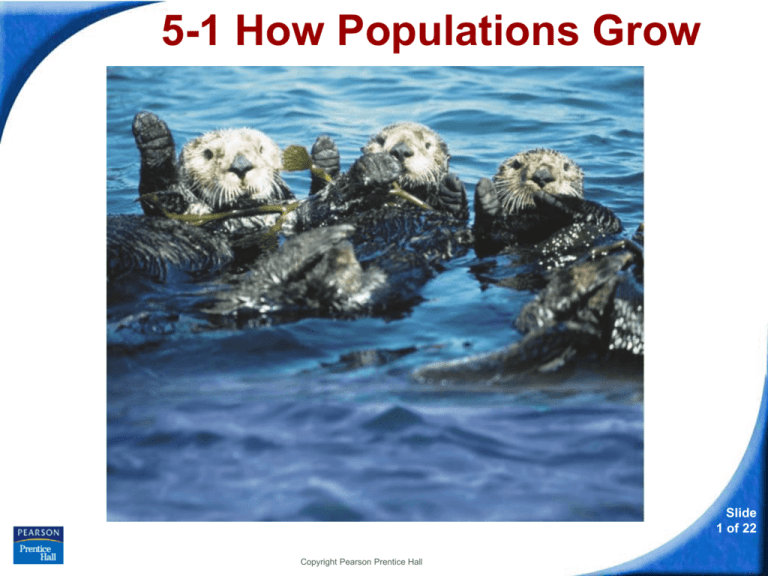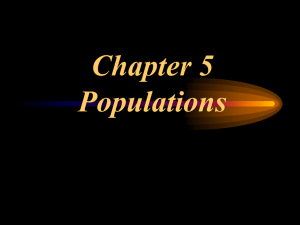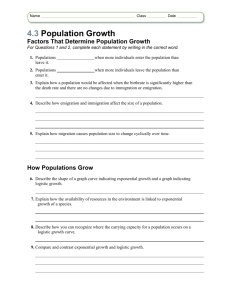
5-1 How Populations Grow
Slide
1 of 22
Copyright Pearson Prentice Hall
5-1 How Populations Grow
Characteristics of Populations
Characteristics of Populations
Three important characteristics of a
population are its:
• 1.
• 2.
• 3.
Slide
2 of 22
Copyright Pearson Prentice Hall
5-1 How Populations Grow
Characteristics of Populations
•Geographic distribution, or range, describes the area
inhabited by a population.
•Population density is the number of individuals per
unit area.
D=
•Growth rate is the increase or decrease of the
number of individuals in a population over time.
Slide
3 of 22
Copyright Pearson Prentice Hall
5-1 How Populations Grow
Population Growth
What factors affect population size?
Slide
4 of 22
Copyright Pearson Prentice Hall
5-1 How Populations Grow
Population Growth
Population Growth rate
Three factors can affect population size:
• the number of __________
• the number of __________
• the number of individuals that enter or leave
the population
_________________ and ________________
A population can grow when its birthrate is greater
than its death rate.
Slide
5 of 22
Copyright Pearson Prentice Hall
5-1 How Populations Grow
Exponential Growth
What are exponential growth and logistic
growth?
Slide
6 of 22
Copyright Pearson Prentice Hall
5-1 How Populations Grow
Exponential Growth
Exponential Growth
Under ___________ conditions with unlimited
resources, a population will grow exponentially.
The population becomes __________________until
it approaches an ________________ large size.
Slide
7 of 22
Copyright Pearson Prentice Hall
5-1 How Populations Grow
Exponential Growth
Exponential Growth
Slide
8 of 22
Copyright Pearson Prentice Hall
5-1 How Populations Grow
Logistic Growth
Logistic Growth
• In nature, exponential growth does not
continue in a population for very long.
As resources become _______________,
the growth of a population ____________.
Logistic growth occurs when a population's
growth slows or stops following a period of
exponential growth.
Slide
9 of 22
Copyright Pearson Prentice Hall
5-1 How Populations Grow
Logistic Growth
Logistic growth is characterized by an S-shaped
curve.
Slide
10 of 22
Copyright Pearson Prentice Hall
5-1 How Populations Grow
Logistic Growth
Carrying Capacity
The largest number of individuals of a population
that a given environment can ___________ is called
its carrying capacity.
When a population reaches the carrying capacity of
its environment, its growth _____________. The
average growth rate is___________.
Slide
11 of 22
Copyright Pearson Prentice Hall
5-1
Click to Launch:
Continue to:
- or -
Slide
12 of 22
Copyright Pearson Prentice Hall
5-1
Population density is the number of individuals
a. that are born each year.
b. per unit area.
c. that immigrate.
d. that emigrate.
Slide
13 of 22
Copyright Pearson Prentice Hall
5-1
When the birthrate of a population exceeds its
death rate, the population
a. decreases.
b. increases.
c. stays the same.
d. increases then decreases.
Slide
14 of 22
Copyright Pearson Prentice Hall
5-1
An S-shaped curve on a graph of population
growth is characteristic of
a. exponential growth.
b. logistic growth.
c. carrying capacity.
d. delayed growth.
Slide
15 of 22
Copyright Pearson Prentice Hall
5-1
Exponential growth in a population slows down
or stops as
a. resources become limited.
b. rate of immigration increases.
c. rate of emigration decreases.
d. birth rate increases.
Slide
16 of 22
Copyright Pearson Prentice Hall
5-1
Exponential growth rate means that each new
generation of a population
a. adds the same number of new individuals as
the previous generation did.
b. increases at the same rate as the previous
generation.
c. is the same size as the generation before.
d. increases by a varying amount.
Slide
17 of 22
Copyright Pearson Prentice Hall
END OF SECTION










